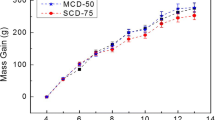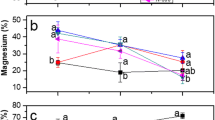Abstract
Phytic acid was extracted from sweet potato (Ipomoea batatas) and fed to Wistar rats with or without zinc for 3 weeks. Animals were then sacrificed and bone and faecal minerals were assessed. The ultra-structure of the bones was examined via scanning electron microscopy. Phytic acid extract or commercial phytic acid supplemented diets (D + Zn + PE or D + PE) displayed reduced bone calcium levels (101.27 ± 59.11 and 119.27 ± 45.36 g/kg) compared to the other test groups. Similarly, reduced calcium were observed in the control groups (D + Zn and D) fed formulated diets with or without zinc supplementation (213.14 ± 15.31 and 210 ± 6.88 g/kg) compared to the other test groups. The group fed supplemented commercial phytic acid diet (D + CP) demonstrated the lowest femur magnesium (3.72 ± 0.13 g/kg) while the group fed phytic acid extract supplementation (D + PE) recorded the highest level (4.84 ± 0.26 g/kg) amongst the groups. Femur iron was highest in the group fed commercial phytic acid supplemented diet (D + CP −115.74 ± 2.41 g/kg) compared to the other groups. Faecal magnesium levels were significantly higher in the two test groups fed phytic acid extract with or without zinc (D + Zn + PE or D + PE) compared to all other groups. All the groups which had phytic acid supplemented diets had significantly thinner bone in the trabecular region, compared to the groups fed formulated diet or zinc supplemented formulated diet (D or D + Zn). These observations suggest that the consumption of foods high in phytic acid may contribute to a reduction in the minerals available for essential metabolic processes in rats.



Similar content being viewed by others
References
Anshu B, Neelam K (2002) Effect of fermentation on phytic acid and in vitro availability of calcium and iron of Doli Ki Roti-An indigenous fermented bread. Ecol Food Nutr 41(3):243–253
AOAC (2000) Official methods of analysis, 17th edn. Association of Official Analytical Chemists, Gaithersburg, MD, USA, pp 20877–22417
Chiesi M, Schwaller R (1994) Reversal of phospholamban-induced inhibition of cardiac sarcoplasmic reticulum Ca2+-ATPase by tannin. Biochem Biophys Res Commun 202:1668–1673
Davidson S, Passmore R, Brock JF, Truswell AS (1975) Human nutrition and dietetics, 6th ed. Longman Group limited, London, pp 109–112
Davis NT, Reid H (1979) An evaluation of phytate, zinc, copper, iron and manganese contents of and Zn availability from soya-based textured vegetable-protein meat-substitutes or meat extenders. Br J Nutr 41:579–589
Dilworth LL, Omoruyi FO, Simon O, Morrison EY, Asemota HN (2005) The effect of phytic acid on the levels of blood glucose and some enzymes of carbohydrate and lipid metabolism. West Indian Med J 54(2):102–106
Dilworth LL, Omoruyi FO, Simon O, Morrison EY, Asemota HN (2004) Hypoglycemia and faecal minerals in rats fed phytate. Nutr Food Sci 34(2):60–64
Fox CH, Eberl M (2002) Phytic acid (IP6), novel broad-spectrum anti-neoplastic agent: a systemic review. Complement Ther Med 10:229–234
Guyton AC, Hall JE (1996) Textbook medical of physiology, 9th edition. WB Saunders, London, pp 396–430
Holt R (1955) Determination of phytate phosphorous. J Sci Food Agric 6:136–142
http://www.webmd.com/hw/lab_tests/hw6212.asp-accessed 2006
http://www.familydoctor.co.uk/htdocs/OSTEOPOROSIS/OSTEOPOROSIS_specimen. html Citied 14 Apr 2005
Lopez HW, Coudray C, Bellanger J, Younes H, Deminge C, Remesy C (1998) Intestinal fermentation lessens the inhibitory effects of phytic acid on mineral utilization in rats. J Nutr 128:1192–1198
Lott J, Ockenden I, Raboy V, Batten G (2000) Phytic acid and phosphorus in crop seeds and fruits: a global estimate. Seed Sci Res 10:11–33
Mega JA (1982) Phytate Its chemistry, occurrence, food interactions, nutritional significance and methods of analysis. J Agric Food Chem 30:1–9
Momcilovic B, Belonje B, Giroux A, Shah BG (1975) Total femur zinc as the parameter of choice for a zinc bioassay in rats. Nutr Rep Int 12:197–203
Moore KL (1985) Clinically oriented anatomy, 2nd edn. Lippincott Williams and Wilkins, Philadelphia, PA, pp 23
Owen RW, Weisgerber UM, Spiegelhalder B, Bartsch H (1996) Faecal phytic acid and its relation to other putative markers of risk of colorectal cancer. Gut 38(4):591–597
Phillipy BQ (2003) Inositol phosphate in foods. Adv Food Sci Nutr Res 45:1–60
Potter JG, Coffman KD, Reid RL, Kroll JM, Abrink MJ (1981) Effects of test meals of varying fiber content on plasma insulin and glucose response. Am J Clin Nutr 34:328–334
Reeves PG (1997) Components of the AIN-93 diets as improvements in the AIN-76A diet. J Nutr 127(5 Suppl):838S–841S
Samotus B, Schwimmer S (1962) Indirect method of determination of phytic acid in plant extracts containing reducing substances. Biochim Biophys Acta 57:389–391
Schlussel YR (2003) Mineral Absorption and deficiency, www.thelifetree.com. Citied December 2006
Shamsuddin AM, Vicenik I, Cole KE (1997) IP6: a novel anticancer agent. Life Sci 61:343–354
Singh RP, Sharma G, Mallikarjuna GU, Dhanalkshmi S, Agarwal C, Agarwal R (2004). In vivo suppression of hormone-refractory prostate cancer growth by inositol hexaphosphate: induction of insulin-like growth factor binding protein-3 and inhibition of vascular endothelial growth factor. Clin Cancer Res 10:244–250
Sokal RR, Rohlf FJ (1969) The principles and practice of statistics in biological research. Freeman, San Francisco, CA, pp 469–484
Weaver CM (1992) Calcium bioavailability and its relation to osteoporosis. Proc Soc Exp Biol Med 200:157–160
Yonekuru L, Suzuki H (2003) Some polysaccharides improve zinc bioavailability in rats fed a phytic acid-containing diet. Nutr Res 23:343–355
Yoon J, Thompson LU, Jenkins DJA (1983) The effect of phytic acid on the rate of starch digestion and blood glucose response. Am J Clin Nutr 38:835–842
Zhu M, Phillipson JD, Greengrass PM, Bowery NE, Cai Y (1997) Plant polyphenols: biologically active compounds or non-selective binders to proteins? Phytochemistry 44:441–447
Author information
Authors and Affiliations
Corresponding author
Rights and permissions
About this article
Cite this article
Dilworth, L., Omoruyi, F.O., Reid, W. et al. Bone and faecal minerals and scanning electron microscopic assessments of femur in rats fed phytic acid extract from sweet potato (Ipomoea batatas). Biometals 21, 133–141 (2008). https://doi.org/10.1007/s10534-007-9101-z
Received:
Accepted:
Published:
Issue Date:
DOI: https://doi.org/10.1007/s10534-007-9101-z




